| Clipper City of Adelaide. May 1883. | |||
| The City of Adelaide, from Sydney, was compelled by sheer stress of weather to put into Jervis Bay until the weather abated. | |||
 | |||
| |||
| Today - City of Adelaide is the world's oldest surviving clipper ship. | |||
 First Class Cabins. First Class Cabins. | |||
|
City of Adelaide is of composite construction with timber planking on a wrought-iron frame. This method of construction provides the structural strength of an iron ship combined with the insulation of a timber hull. She was amongst the fastest clippers on the London - Adelaide run, sharing the record of 65 days with the clipper Yatah. She played an important part in the immigration of Australia. An estimated 250.000 Australians can trace their ancestory to the City of Adelaide. With the arrival of steamships, the City of Adelaide was sold into the north American timber trade, where it worked for six years as a cargo ship. | |||
 | |||
| In 1989 it was moved onto a private slip in Irvine, where it remained until rescued by Australian volunteers and brought to Port Adelaide in 2014. She is currently undergoing restoration and her final resting place is still being decided.
| |||
 |
8 December 2016
1883–Historic vessel seeks shelter in Jervis Bay.
Subscribe to:
Post Comments
(
Atom
)

No comments :
Post a Comment